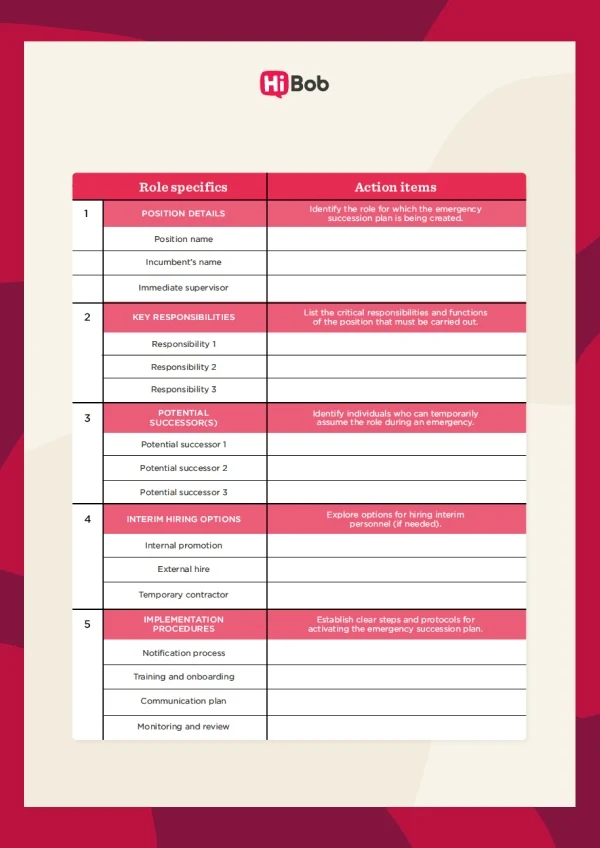Bolster your business with succession planning
Talent shortages. Surprise resignations. Widening skill gaps.
They’re all part and parcel of today’s tumultuous workplace. But one of the ways you can bolster your company to ensure it’s business-as-usual is to have a rock-solid succession plan in place.
Succession planning, defined by the CIPD as “identifying and growing talent to fill leadership and business-critical positions in the future,” is a much-required staple in today’s business landscape.
In this blog post, we look at how to measure succession planning, some key succession planning metrics to track progress, and how succession planning helps set the stage for a resilient and thriving future.
<<Download our free succession planning template to build an effective plan.>>
Key insights
- Succession planning ensures your organization is prepared for future leadership transitions by identifying and nurturing talent for critical roles
- Tracking metrics like bench strength, promotion rates, time-to-fill, and career path ratios helps align succession strategies with business goals
- Monitoring diversity, retention, and risk of loss ensures your plan remains inclusive, stable, and adaptable to workforce changes
Why measuring the success of your succession plan is important
According to Gartner, “succession planning can help ensure the organization has the right leadership with the right skills at the right time.”
As with any plan, it’s crucial to know what success looks like, so you can keep a yardstick of accomplishments and problems for your succession plan.
Firstly, tracking measurable progress metrics, consistently reporting results, and setting manageable targets means your succession plan can prove your successes over time. Even if you only track a single metric—ideally attaching a dollar value to it—it’s a tangible way to prove your successes to stakeholders.
Many companies use this approach to compare year-on-year progress, helping teams to properly allocate resources to remain successful in the coming years. This is particularly important for training and development, helping HR professionals identify key leaders and nurture internal talent for future leadership roles.
Keeping promotions and talent in-house reduces the costs associated with recruiting and hiring talent externally.
Identifying in-house talent early also allows HR professionals to plan ahead, prepare their organization for any future leadership transitions, and build exit strategies if there are disruptions.
How to measure and efficiently track succession planning
The key to succession planning is to align your succession management metrics with your company goals. To start, clearly define these organizational goals within your formal plan. This will help guide you on which metrics to choose.
There are two types of metrics to choose from—objective, which provide quantitative values (such as time-to-fill and retention metrics), and subjective, which provide qualitative values (such as company culture and team satisfaction).
Whichever metrics you choose, you can use any existing data on hiring, promotions, and retention to help create processes around decision-making and data collection.
Once you’ve chosen your goals, metrics, and processes, there are a few more tasks to help plan succession in your organization:
- Identify critical roles
- Define succession criteria
- Assess your talent
- Implement development and training
- Increase efforts for mentoring, coaching, and one-on-ones
- Refine knowledge transfer processes
- Continuously track, review, and update your succession plan
Recommended For Further Reading
Top succession planning metrics
There are many different metrics to choose from—both qualitative and quantitative—to measure how well your succession plan is performing. Here are just a few examples of the most common key metrics.
1. Bench strength
Bench strength is succession planning’s make-or-break metric. Borrowed from basketball, it’s a measurement of the talent you have “sitting on the bench”—people who aren’t playing but are in shape to play.
Talk to your managers and ask them who’s showing promise on their team, who’s interested in leadership opportunities, and who’s capable of moving up the ranks. Bench strength is about having strong team players who can take on more challenging positions and responsibilities if necessary.
Without these people, you’ll be forced to hire from the outside—an expensive and time-consuming process.
2. Proportion of critical positions filled internally
This metric tracks your organization’s ability to develop internal talent by looking at the percentages of critical roles filled internally compared to external hires.
The higher the percentage of critical roles hired externally, the more likely you need to reevaluate your internal training and development to support your succession plan.
3. Time-to-fill
Time-to-fill is the time it takes to find and hire a new candidate. It’s usually calculated as the number of working days between a new role requisition and a candidate accepting the offer.
This metric measures the efficacy of your organization’s recruitment efforts and hiring processes. If you’re creating a succession plan based on external hires, lowering your time-to-fill is critical to that plan’s success.
4. Career path ratio
The career path ratio metric measures your people’s rate of growth based on vertical and lateral movement within your organization.
To calculate it, divide the total number of promotions in your organization by the sum of all role changes (both upward and lateral moves) to give you a number between 0 and 1.
High career path ratio—any number above 0.7—signals frequent promotions and opportunities to take on greater responsibilities. Low results—under 0.2—signal issues with the promotion process, or too many lateral movements.
Aim to be as close to 1 as possible to ensure your people are upskilling and better prepared for promotions.
5. Diversity metrics
Diversity and inclusion initiatives have countless benefits for your organization, from better representation to better decision-making and higher returns. Ultimately, DEI&B is vital to setting your teams up for future success.
You can measure your workforce’s diversity by looking at your organization’s:
- Pay gap
- Gender, age, and racial diversity ratios
- Regional diversity benchmarks
6. Retention
Does your organization look like a revolving door of entrances and exits? Chances are your employee retention rate might be low, and you need better succession planning.
Retention is an early indicator of employee happiness. So the goal here is to keep your organization happy and functioning at every level.
7. Critical positions with 3 or more successors
Are there multiple candidates ready for promotion into a new higher position in the near future? This bodes very well for your succession planning and indicates that your organization is in a more stable position with multiple talent options and prepared in case of sudden departures, for instance.
This metric also measures how effective your leadership development programs are. A successful development program will show candidates progressing steadily up the readiness levels.
8. Readiness
Speaking of readiness, this metric measures how well-prepared an organization is to fill newly vacant critical roles—typically leadership and C-suite roles.
To measure this readiness, HR professionals can look at a candidate’s skills, previous experience, and potential to assess if this person is ready to step up into the new role.
One easy way to assess this qualitatively is simply to ask managers if this person is ready. To assess this quantitatively, you can also look at the average number of years it takes a team member to be ready for a new role. Ideally, the average number should decrease, showing that candidates are taking less time to step into future roles.
9. Risk of loss
Also known as “flight risk,” this metric looks at how likely a person is to leave the company within the next six months, based on their engagement with their current role.
While this is a difficult metric to measure effectively, there are some possible indicators of a potential increase to risk of loss:
- Pay dissatisfaction
- Sudden unwanted change in their role
- Major life changes, like relocation or sudden loss of a significant person
You can also measure these levels of satisfaction through one-on-one conversations with managers, annual surveys, and compensation analysis to ensure your people always feel satisfied with their pay.
10. Performance
Last but not least, people’s performance is a key metric for tracking your succession planning. This counts for every person, and managers need to know how well their people are working together and with their customers, as well as the quality of their work.
For example, you can measure the performance and productivity of people who take on new leadership roles—or even of the organization as a whole during the same period.
<<Download our free succession planning template to build an effective plan.>>
Plan to succeed, succeed to plan
Succession planning is the key to staying resilient as an organization, helping to weather the storms of everyday events, and ensuring your company stays business-as-usual. Going beyond mitigating risks, though, succession planning is a commitment to your people that builds an action plan that identifies and retains top talent inside your organization.
In today’s volatile work world, there is a clear need for organizations to take a long-term approach to succession planning. Rather than just filling roles, the best succession plans empower, engage, and retain valuable talent for a thriving future.



